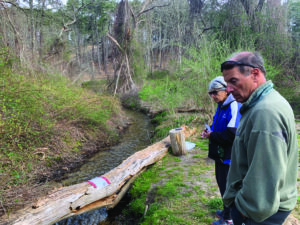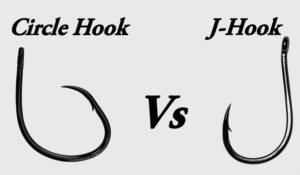WELLFLEET — Barbara Brennessel, a biologist from Wellfleet, was once approached by law enforcement near the wooded junction of Old Kings Highway and Black Pond Road just south of the Truro town line. The cops suspected she was poking around in the bushes along the Herring River because she was cultivating a marijuana patch.
She showed them her permit from the Mass. Div. of Marine Fisheries (DMF). The officers turned on their heels, letting Brennessel return to her herring counting shift.
“You can see how they blend in,” she said during a recent weekend count, nodding at a cluster of silvery herring wriggling upstream. Brennessel counted eight. Ditto for Nick Picariello, her husband, who kept watch from a nearby tree stump.
“Look, here comes some more!” he said, moments after Brennessel jotted down the number on her data sheet.
One trick for spotting oncoming herring, particularly the livelier ones: be on the lookout for white-water ripples moving opposite to the direction of the current. Sure enough, a party of five splashed their way toward us, twisting around the bend and gliding up a straightaway that led the fish toward a culvert — a pipe that shunts the stream beneath the road.
Derrick Alcott, an aquatic ecologist, has found that culverts form chokepoints in the Herring River system, which create “feeding tubes” for predators. Snapping turtles, for one, are known to lurk in the culverts, waiting to lunge at passing herring.
We watched the herring slow down and hesitate before the opening of the culvert. “Usually, it takes one brave one to go,” Brennessel said. “Then, the rest follow along.”
That culvert marks the last stretch of the herring’s journey from the sea to Wellfleet’s network of kettle ponds, where the fish spawn. Since April 1, Wellfleet’s 30-some volunteers have been hiking out to this wooded spot, filling herring count shifts in the morning, afternoon, and evening. Each shift runs for 10 minutes. On the morning of April 16, around 8:30 a.m., Brennessel, Picariello, and I tallied 63 herring in all.

The data collected during the counts is sent off to statisticians at the DMF to estimate the size of Wellfleet’s herring run. In the late 1800s and early 1900s, the run in Wellfleet’s Herring River was in the hundreds of thousands, but in recent years annual totals have declined to the tens of thousands, according to data compiled by the Association to Preserve Cape Cod and the Mass. Bays National Estuary Partnership. Last year, the run was estimated at 31,710 fish.
In 2006, the National Marine Fisheries Service named river herring a “species of concern.” That same year, the Mass. DMF closed the herring fishery completely. The shutdown was supposed to last for three years, but the fishery has remained closed ever since. The river herring decline is tied to a string of factors, writes Brennessel in The Alewives’ Tale, her book about the life history and ecology of river herring.
For starters, manmade impediments like the dams and the Chequessett Neck Road dike, as Alcott found as the lead author of a 2021 study, block herring from reaching their spawning grounds. Habitat loss is another contributor, as coastal development has degraded estuaries and streams. Overharvesting, Brennessel added, was another likely reason.
Brennessel has been involved with the volunteer herring count in Wellfleet since 2009. When I asked her if she noticed any trends in the numbers over the years, she couldn’t say for certain. She did identify a blind spot in the numbers: run size estimates are based largely on daytime counts, when volunteers can better spot the fish. For all we know, she said, a good number of herring may be passing by under the cover of night.
“Why should we be concerned about a humble fish that lacks the charisma of other inhabitants of Earth’s waters, such as whales, sea turtles, salmon, and dolphins, whose populations are also in decline?” Brennessel writes in The Alewives’ Tale. “The answer to this question is rooted in the ecological web, where a small creature can make a big difference in the scheme of things…. These small creatures are important forage base, providing a source of protein and lipid for other fishes, birds, and mammals.” Among these are striped bass, bluefish, ospreys, otters, and even dolphins.
After our 10-minute shift, we walked toward Herring Pond, strolling past the finish line for these sojourner fish. Picariello pointed out a pile of raccoon scat. It gleamed with undigested herring scales.
The DMF has asked volunteers to keep counting until June 15. The “New England rule of thumb” for this, however, involves keeping tabs on what’s blooming. When the forsythia come out, Brennessel told me, that’s when you know the first part of the herring run (alewives) is about to start. “The blooming of lilacs tells us the second aspect of the run — blueback herring — is starting,” she said.
Editor’s note: An earlier version of this article, published in print on May 12, erroneously reported that the blooming of forsythia signaled the end of the herring run rather than the beginning.
 PROVINCETOWN — The much quieter than normal waterfront businesses are anxiously waiting to see what Gov. Baker does with the current stay-at-home and social distancing policies. It has given boat owners plenty of time to do all those little jobs on their boats they never had time for in a typical spring. Given Boston’s cancellation of all outdoor summer events, it’s hard to believe Cape towns will go the opposite way.
PROVINCETOWN — The much quieter than normal waterfront businesses are anxiously waiting to see what Gov. Baker does with the current stay-at-home and social distancing policies. It has given boat owners plenty of time to do all those little jobs on their boats they never had time for in a typical spring. Given Boston’s cancellation of all outdoor summer events, it’s hard to believe Cape towns will go the opposite way.